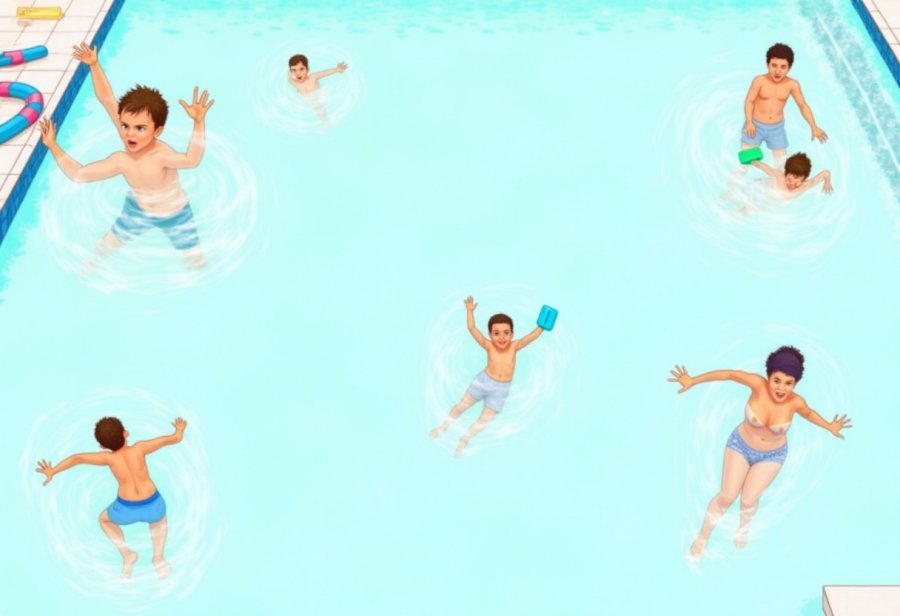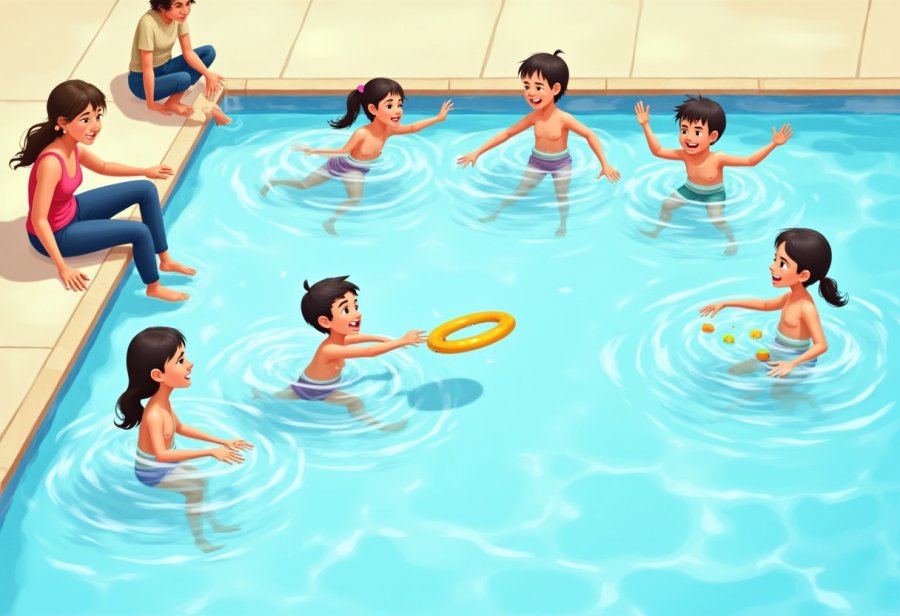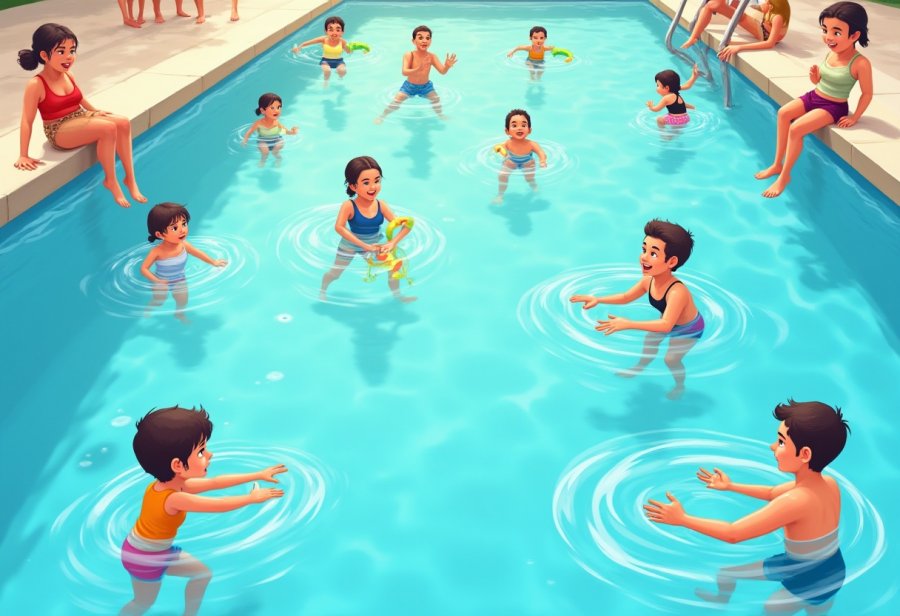What if the greatest obstacle to learning how to swim isn’t the water itself, but the fear of taking that first courageous step? This inspiring journey transforms water from a source of anxiety into a space of confidence, safety, and freedom—regardless of age. From nervous beginners clutching floaties to adults overcoming long-held fears, each small victory builds resilience and trust in oneself. The process involves patience, steady practice, and celebrating progress, turning initial hesitation into joy and mastery. This guide explores overcoming common misconceptions, tackling emotional hurdles, and applying swimming skills to enhance safety, health, and life—empowering readers to see water not as an enemy but as a welcoming environment. The path from fear to freedom is gradual, but with persistence, water becomes a realm of empowerment, adventure, and lifelong confidence, urging you to discover what’s possible once you decide to take that first leap.

Unlock Your Confidence: The Transformative Power of Learning to Swim
Learning to swim is about more than just mastering a new skill; it’s a transformative experience that can change how you see water—and yourself. For people of all ages, becoming comfortable in the water boosts confidence, enhances safety, and opens up a world of fun and relaxation. Whether you’re dipping your toes into the pool for the first time or facing a long-held fear, the journey into water can be surprisingly empowering.
Many people initially see water as intimidating or even frightening. That’s a normal part of starting out, but it doesn’t have to hold you back. The process begins with small, manageable steps—learning to float, breathe steadily, and get comfortable in shallow water. These basics set the foundation for more advanced skills and help you build trust in your own abilities.
What makes learning to swim so valuable is its universal relevance. It’s not just a skill for kids; adults can benefit just as much. Overcoming water fears later in life often leads to a sense of freedom and confidence that spills into other areas of life. Swimming becomes a way to stay active, relax, and enjoy water without worry, transforming water from a source of anxiety into a space of safety and enjoyment.
This journey isn’t about perfection but progress. Every splash, every breath, and every new stroke is a step forward. As you gain experience, your confidence grows naturally, and water begins to feel less like a problem and more like a safe haven. The sense of achievement from each small victory encourages you to keep going, gradually turning water into a place of joy and self-assurance.
Learning to swim also offers lasting benefits beyond personal confidence. It’s a skill that can save lives and make water-based activities safer and more accessible. Whether at the beach, pool, or lake, being able to swim provides a sense of control and independence that’s hard to match. Starting this journey at any age can open up a new world of possibilities, where water becomes a space of growth rather than fear.
The Learning Journey: Building Water Confidence Step by Step
Mastering swimming is a process built on consistent effort and patience. It begins with mastering basic skills like floating, breath control, and simple strokes, which serve as the foundation for everything that follows. When these fundamentals become familiar, building confidence in deeper water or trying more advanced techniques becomes much smoother. The key is regular practice and celebrating small wins—whether it’s relaxing in the water or swimming across the pool without stopping. These tiny successes reinforce your progress and motivate you to keep advancing.
As you gain experience, you’ll start to feel your body more in water. You learn how to breathe steadily, stay balanced, and move efficiently. These skills don’t develop overnight; they come from repeated effort and gentle experimentation. It’s normal to face setbacks or feel frustrated when progress feels slow, but perseverance is essential. Each time you get in the water, you’re building trust in yourself and your abilities, even if only for a few minutes.
Progression involves gradually increasing challenges, like swimming in deeper water or trying different strokes. However, rushing can lead to frustration or reinforce fears, so it’s best to take things at your own pace. Patience allows confidence to grow naturally. Over time, those small steps add up, transforming initial hesitation into a sense of ease and enjoyment. Remember, it’s not about perfection but steady improvement and positive associations with water.
Starting today, even dedicating a few minutes each week to practice can make a difference. Seek out friendly classes or tutorials that guide you through each stage safely. The longer you wait, the more opportunities you miss to develop skills that last a lifetime. Every splash, breath, and stroke is a step closer to feeling comfortable and confident in water, turning what once felt intimidating into something joyful and empowering.
The journey of mastering swimming is as much about mindset as it is about technique. With patience, persistence, and a willingness to learn, water transforms from a source of fear into a space of freedom. Every effort you put in builds resilience, confidence, and a lifelong skill that can enrich your life in countless ways. The progress may be gradual, but the rewards are well worth the effort.

Focus Points for Beginners: Overcoming Fear and Ensuring Safety in the Pool
Starting your journey as a beginner swimmer means focusing on a few core skills that set a strong foundation for confidence and safety. Learning to float is essential; it teaches your body to relax and stay balanced in water, helping to reduce anxiety and build trust. Practicing steady, rhythmic breathing is just as important—calm, consistent breath control prevents panic and makes movements feel more natural. Once these basics are secure, moving on to simple strokes like front crawl or backstroke allows you to glide more smoothly and build endurance gradually.
Overcoming water fear is often the biggest hurdle, but patience and gentle exposure make a difference. Starting in shallow areas where you can touch the bottom provides a safe space to get comfortable with water. Using flotation devices can support your efforts, giving you a sense of security as you practice breathing and floating. Breaking the process into small, manageable steps—like splashing water on your face or sitting in the water—helps lessen anxiety and makes water less intimidating.
Pool safety for beginners is crucial. Always stay in shallow water where you can stand comfortably, and never swim alone. Basic rules—such as avoiding running on the deck or jumping into the pool without checking the depth—help prevent accidents. Wearing safety gear like floaties or kickboards can boost confidence early on, but they should be used alongside proper technique and supervision. Keeping an eye on water temperature and pool conditions ensures a safe, comfortable environment to learn and grow.
Building confidence in water isn’t just about physical skills; it’s also about mental readiness. Celebrate small victories, such as floating unaided or swimming short distances, to reinforce your progress. Remember, everyone starts as a beginner, and each effort contributes to your trust in water. Consistent practice and maintaining a positive mindset will gradually turn fears into familiarity, transforming water from a source of anxiety into a space of safety and enjoyment.
Starting today makes a real difference. Even dedicating a few minutes weekly to water practice can lead to noticeable confidence gains. Seek out friendly classes or tutorials that guide you safely through each stage. The longer you wait, the more opportunities you miss to develop lifelong skills. Every splash, breath, and stroke brings you closer to feeling comfortable and confident, turning water into a space of fun and freedom.
Keep in mind that setbacks are normal—they’re part of learning. Days when fears resurface or progress stalls are opportunities to understand what needs more attention. Patience, persistence, and small, consistent efforts build resilience and trust in your abilities. With time and support, water transforms from a daunting obstacle into an environment where confidence and safety thrive.
Building on the importance of safety and technique, it’s also helpful to familiarize yourself with essential swimming safety tips to prevent accidents. Understanding how to respond in emergency situations can make a significant difference in ensuring a safe swimming experience. For more detailed guidance, exploring resources on swimming safety tips can provide valuable insights and reassurance, such as this comprehensive guide on swimming safety tips.
Challenges and Conflicts in Learning to Swim: Navigating Obstacles and Misconceptions
Learning to swim isn’t always a straightforward journey, and many face obstacles that can slow progress or dampen motivation. One common misconception is that swimming lessons are only for kids, which discourages many adults from trying. This idea overlooks the fact that water safety and confidence are valuable at any age, and it’s never too late to start. Believing that fears are insurmountable can also hold people back—many assume that anxiety or past negative experiences mean they’ll never feel comfortable in water. But with patience and gentle exposure, most fears can be addressed and diminished over time.
Conflicting advice about how quickly to progress adds to the confusion. Some instructors advocate rapid mastery, pushing learners to move fast, while others emphasize a slow, steady approach. These differing philosophies can leave students feeling unsure about what pace is right for them. Rushing often leads to frustration and a sense of failure, whereas a patient, gradual method allows confidence to build naturally. Everyone learns differently, and respecting your own rhythm is key to sustainable progress.
Societal attitudes can also create emotional hurdles. Many adults worry about being judged for their skill level or for struggling with water fears. This stigma can make seeking help or practicing openly feel intimidating, adding to feelings of isolation. Recognizing that water anxiety is common and temporary helps normalize the experience, making it easier to keep moving forward without shame.
Setbacks are part of the learning process, yet they’re often overlooked in conversations about progress. Days when fears resurface or progress stalls can feel discouraging, but they’re also opportunities to understand what needs more attention. Persistence outweighs perfection—every challenge faced and overcome strengthens resilience and trust in oneself. Inconsistent practice can slow progress, so even brief, regular water exposures help reinforce skills and reduce anxiety over time.
Understanding these obstacles and misconceptions fosters a more compassionate view of the journey. Recognizing that struggles and setbacks are normal makes it easier to stay committed. With patience, support, and a realistic mindset, overcoming these challenges becomes an integral part of transforming fear into water confidence.
Application of Swimming Skills in Life: Enhancing Safety, Health, and Personal Growth
Knowing how to swim can significantly influence your daily life in practical and meaningful ways. When you’re confident in water, you gain a crucial safety net—whether at the beach, by the pool, or during boating trips. Being able to float or swim to safety in an emergency can prevent panic and save lives, giving you peace of mind in water-related situations. This sense of security is especially valuable for families, outdoor enthusiasts, and anyone spending time near water.
Beyond safety, swimming opens up a world of enjoyment and relaxation. When you’re comfortable in water, participating in water-based activities becomes effortless. Whether it’s playing with children, taking a refreshing dip after a workout, or trying out water sports like paddleboarding or snorkeling, swimming transforms water from something intimidating into a space for fun and connection. It invites spontaneous adventures and shared experiences that strengthen bonds.
Regular swimming also offers notable health benefits. It’s a low-impact full-body workout that improves cardiovascular health, flexibility, and muscle strength. For people of all ages, making water a part of your routine can boost mood, reduce stress, and increase overall well-being. Developing water confidence encourages more consistent physical activity, making health benefits accessible and sustainable over the long term.
Learning to swim can also foster personal growth. Overcoming fears and mastering new skills build resilience, patience, and discipline. These qualities extend beyond the pool, helping you face other challenges with confidence and persistence. The sense of achievement gained from each milestone reinforces your ability to tackle obstacles both in water and in life.
Communities benefit when more people learn to swim. Promoting water safety and confidence reduces drowning risks and creates inclusive, supportive environments. When water becomes a shared space of safety and enjoyment, it encourages outdoor recreation, family bonding, and social connection. The collective confidence in water fosters a culture of awareness and respect for water safety.
Finally, mastering swimming empowers you with a lifelong skill that enriches your independence. It encourages exploration and adventure while ensuring safety remains a priority. Whether seeking leisure, health, or safety, swimming is a versatile, valuable skill that enhances your quality of life. Investing in water confidence today opens doors to a safer, more active, and joyful future.

Conclusion: From Fear to Freedom—Embrace Your Water Confidence Journey
The journey from fearing water to feeling confident in it is one of the most rewarding transformations you can experience. It starts with that one brave moment—whether dipping a toe in the shallow end or taking a deep breath to float for the first time. Each small step builds a foundation of trust in yourself and your abilities, gradually replacing anxiety with a sense of mastery. As confidence grows, water ceases to be a source of fear and becomes a space of freedom and joy.
With persistence, what once seemed overwhelming becomes familiar. The panic of the unfamiliar fades, replaced by calm and assurance. Every successful stroke, breathe, or float confirms that you are capable of navigating water safely. This shift isn’t just about physical skills; it’s about changing how you see water and your relationship with it. You begin to view water as a place of safety and possibility rather than danger.
The secret lies in showing up consistently and practicing patience through setbacks. Progress might be slow at times, but each effort chips away at fear and reinforces your trust. The small victories—floating unaided, swimming a few strokes—serve as powerful reminders that fears are temporary, and mastery is within reach at any age. These moments of success fuel your motivation and deepen your belief in yourself.
Building water confidence also cultivates qualities like resilience and discipline—traits that extend well beyond the pool. Overcoming doubts and setbacks strengthens your mental toughness and prepares you to face other challenges with courage. The confidence you gain in water becomes a catalyst for exploring new adventures and embracing life with a more open, fearless mindset.
Remember, it’s never too late to start this journey. Taking that first step might feel daunting, but it opens the door to lifelong benefits—safety, health, and a newfound sense of freedom. Each splash and stroke is a step toward transforming water from an obstacle into an environment of empowerment and joy. The path from fear to freedom is gradual, but every effort brings you closer to a life enriched by confidence, resilience, and the simple pleasure of being at ease in water.






